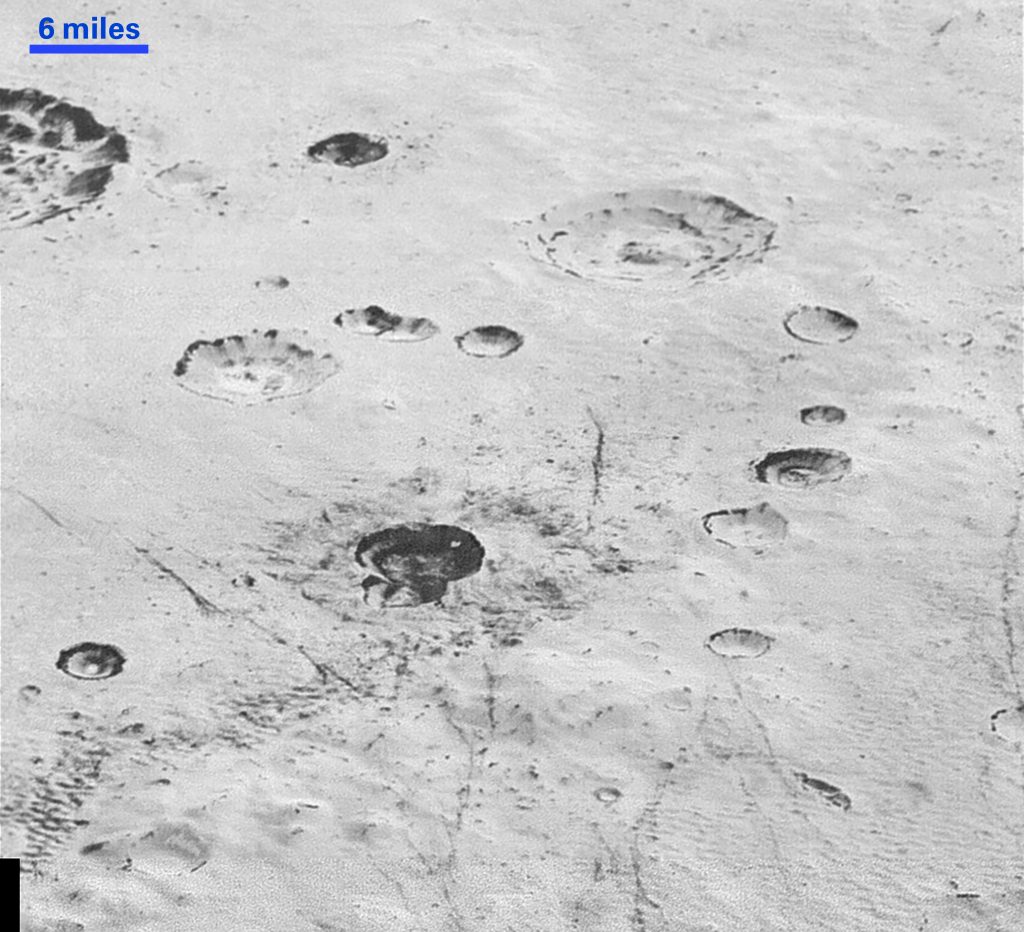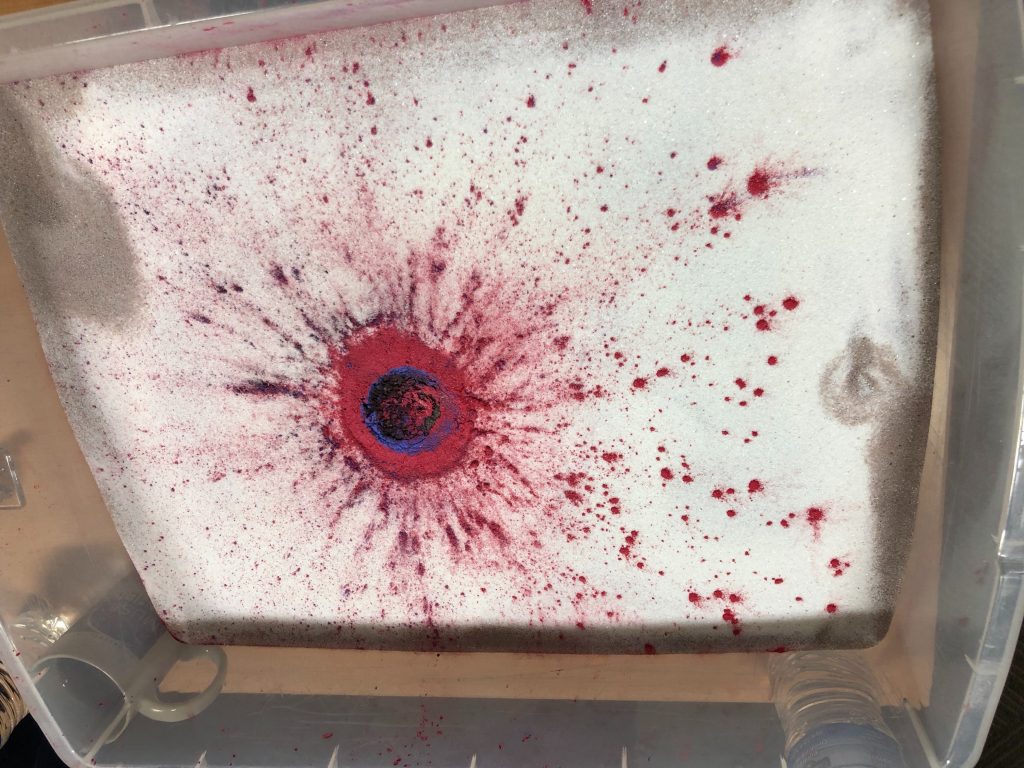Chapter 5: Investigating the Surfaces of Solid Objects in the Solar System

Science Notebook Assignment
Begin a new note for this investigation. Be sure you are continuing to keep your notebook organized and labeled.
Investigation Question:
Do all planet and moon surfaces in the Solar System show the same effects of crater-making impacts from the Late Heavy Bombardment period and why?
As this investigation is all about the nature of craters on the surface of objects in the Solar System, we begin with a general overview of the nature of craters on the Moon. An excellent tool for investigating craters on the Moon is Google Moon, which uses the Google maps / Google Earth interface you are likely familiar with, but applied to maps of the Moon. Every student should open Google Moon and investigate various regions on the surface to get an idea for the properties of craters found on the Moon. We recommend starting with the Apollo 12 landing site, which is labeled with an astronaut icon holding a flag with the number 12 on it. From there, everyone can scroll to the south to investigate a different area of the Moon. The first, whole class discussion we conduct centers around these two questions:
- How might we compare the difference between craters on different parts of the Moon’s surface?
- Do the craters appear the same or similar on all areas of the Moon’s surface?
Science Notebook Assignment
Record notes about your group’s or the whole class discussion on the nature of craters on the Moon. Provide as much detail as you can on the appearance of a variety of craters. Consider how you might describe craters (individually and as a group) quantitatively.
In this investigation, we are first going to learn about a time period in the history of the Solar System that is known as the “Late Heavy Bombardment” (LHB). There are many resources for investigating the ideas behind the LHB, but for a quick introduction, we recommend this BBC video. Either from this video or from another source, you want to find the answers to the following questions to help set the stage for this investigation:
- What was the cause of the Late Heavy Bombardment?
- What were the results of the Late Heavy Bombardment? How widespread were those results?
- When did it occur?
Science Notebook Assignment
Record notes about your group’s or the whole class discussion on the Late Heavy Bombardment. Try to connect the information in the video to your previous work on the nature of the craters on the Moon, by explaining how the LHB is related to the craters on the Moon.
Modeling the formation of craters
One experiment that many students do in a K-12 science class or perhaps for a science fair or other competition is to physically model the creation of craters. We do this in our class in order for students to make some direct observations of simulated craters to understand the process of their formation and evolution over time. We provide several low, wide pans of sand, and give students a variety of masses (small rocks, larger rocks, medium and large ball bearings) to use as simulated impactors. Then, we ask students to experiment with letting their impactors impact their simulated planetary surface and recording some observations of the results.
Questions to consider while doing this are:
- When you compare your model surface to a real surface, like the one you studied of the Moon, can you say what factors were responsible for the variety of craters you saw on the Moon?
- If the pan of sand at the end of the experiment is the surface of the Moon, for example, at the end of the Late Heavy Bombardment, what might happen to the craters in the time since the end of the LHB?
If you would like to review this model, NASA has created a video that does a slightly more sophisticated version of this than we do in our class:

Investigation question:
- How densely packed do the craters appear on the surface? Can you quantify this in some way?
- Are there any other characteristics of the surface that may be relevant for understanding its history?
In your group, after comparing the surfaces, develop an initial claim that responds to the investigation question and is supported by evidence from the images. In particular, consider if there is anything you might say about the history of these objects and how that might relate to their current appearance. However, at this point, be careful to base your claim about the observed properties and observed pattern, as there will be additional opportunity to consider why the objects appear the way they do in order to add scientific reasoning to your argument.
Science Notebook Assignment
We recommend recording your data on the surfaces of these objects in a table that allows you to compare and contrast them more easily. Record your initial claim and evidence at this point.
In order to work on making sense of the additional data, discuss the following questions in your groups:
- What claim or claims can you come up with to answer the investigation question that uses evidence from the entire surface of an object?
-
Does the evidence you gathered from these six (or two in particular) objects support your earlier claims (today)?
Science Notebook Assignment
Record any changes to your initial claim and evidence in your notebook.
Building a model for the nature of the surfaces of worlds in the Solar System
The video you watched early in this investigation provided information on the LHB, which is part of the scientific reasoning scientist in this field have argued helps explain the origin of craters on the objects in the Solar System. Recall that, in the video, they provide their best estimate for when the LHB occurred. To build out the reasoning for this investigation, a large group discussion of the following question comes next:
- What do you think happened to these moons and planets when the craters were created and over the time since then that would have influenced their appearance?
After this discussion, consider the information in the following table about the objects you studied in this investigation:
| Object | Atmosphere | Surface | Geologic activity | Notes | |
|---|---|---|---|---|---|
| Mercury | If any, little bit of material captured from the Sun | Rocky composition, no volcanoes, no water | core has solidified, planet is shrinking like an orange that has dried out | Intense solar radiation since it is so close to the Sun | |
| Earth | Thick atmosphere with frequent weather | Rocky composition, volcanoes, oceans | Earthquakes, active volcanoes, seafloor spreading | Human activity | |
| Earth’s Moon | No atmosphere | Rocky composition, very small volcanoes, other volcanic surface features, no water, some craters near the poles have water ice | Very minor moonquakes, little or no volcanic activity more recent than a billion years ago | The side of the Moon we don’t see looks very different than the side we see, and we have measured the crust to be thicker on that side | |
| Mars | About 1% as thick as the thickness of Earth’s atmosphere | Rocky composition, may have had flowing water oceans long in the past, largest volcanoes in the Solar System, much larger than Earth’s | Do not think it has Marsquakes, most volcanic activity likely ended about 100 million years ago | Has strong winds that generate huge dust storms that can cover half the planet all at once | |
| Vesta | No atmosphere | Rocky composition similar to the Moon, with a giant crater almost as big as the entire object | Do not think it has Vestaquakes, no volcanoes, but may have been covered in lava long in the past | The second largest asteroid in the asteroid belt, not entirely spherical | |
| Europa | If it has an atmosphere it is very thin | Icy crust covering what we think is a huge saltwater ocean | No Europaquakes or volcanoes | Looks similar to Earth’s arctic regions as seen from space |
After considering the results of your discussion and the information in the table, your group should agree upon answers to these final questions:
-
What happened to the craters on that object over time?
-
Think about anything that might have happened to the surface of the objects that could have changed or destroyed craters.
-
-
Why do the objects have different crater densities?
Science Notebook Assignment
Based on your final discussions, revise your claim as necessary, and write a final claim, support it with evidence from your image analysis, and record the scientific reasoning you agreed upon during your discussions.

